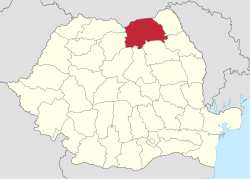Suceava County
|
Suceava County Județul Suceava |
||
|---|---|---|
| County | ||
|
||
 |
||
| Coordinates: 47°35′N 25°46′E / 47.58°N 25.76°ECoordinates: 47°35′N 25°46′E / 47.58°N 25.76°E | ||
| Country | Romania | |
| Development region | Nord-Est | |
| Historical region | Southern Bukovina | |
| Capital | Suceava | |
| Area | ||
| • Total | 8,553 km2 (3,302 sq mi) | |
| Area rank | 2nd | |
| Population (2011 census) | ||
| • Total | 634,810 | |
| • Rank | 8th | |
| • Density | 74/km2 (190/sq mi) | |
| Telephone code | (+40) 230 or (+40) 330 | |
| ISO 3166 code | RO-SV | |
| Website |
County Council Prefecture |
|
Suceava (Romanian pronunciation: [suˈt͡ʃe̯ava]) is a county (județ) of Romania, comprising mainly the historical Moldavian region of southern Bukovina, and a few villages in Transylvania, with the capital city at Suceava.
In 2011, Suceava County had a population of 634,810, with a population density of 74/km2.
This county has a total area of 8,553 square kilometres (3,302 sq mi).
The western side of the county consists of mountains from the Eastern Carpathians group: the Rodna Mountains, the Rarău Mountains, the Giumalău Mountains and the Ridges of Bukovina with lower heights. The county's elevation decreases toward the east, with the lowest height in the Siret River valley.
The rivers crossing the county are the Siret River with its tributaries: the Moldova River, the Suceava River and the Bistrița River.
The predominant industries in the county are:
The main tourist attractions in the county are:
The Suceava County Council, elected at the 2016 local government elections, is made up of 37 counselors, with the following party composition:
Suceava County has 5 municipalities, 11 towns and 98 communes
During June 2010, Gheorghe Flutur, the president of Suceava County, told the Mediafax news agency that his region was one of the worst hit in the country. In the morning of June 29th, relief work was coordinated to deal with flooding that killed 21 people, and caused hundreds to be evacuated from their homes.
...
Wikipedia

